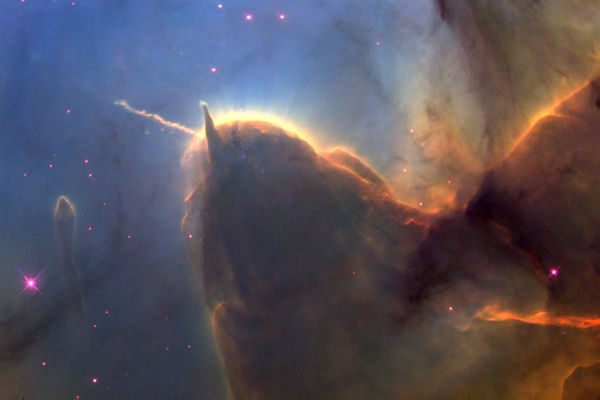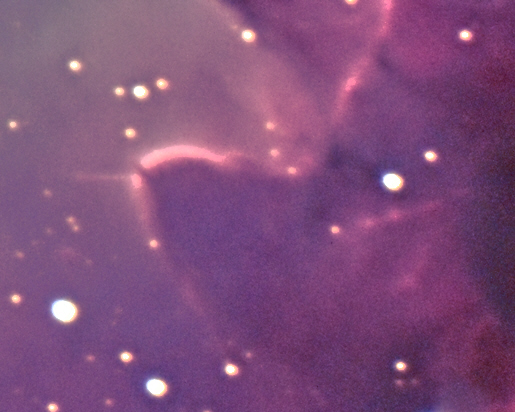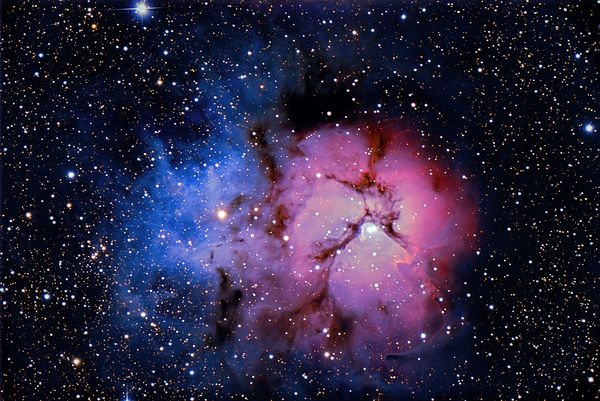Night of the Trifid
Jun 22, 2020 15:49:19 #
Ballard
Loc: Grass Valley, California
Last night I took a some shots of the Trifid nebula. The Trifid nebula (also known as Messier object 20) is around 4100 light years away and is a star forming region in the constellation of Sagittarius. Note the dark areas in and around the nebula is dust that obscures the background stars. The image below was made with a stack of 28, 5 minute exposures at F10 with a focal length of 4096mm. The image was taken with a full frame canon DSLR with the ISO set to 800. The title was intended to make a bit of fun of the old grade B scifi movie "Day of the Triffids" from 1962 when I was just a kid (The spelling is slightly different but pretty close to the name of the nebula). All comments, questions and suggestions are welcome.
Jun 22, 2020 16:07:48 #
Jun 22, 2020 16:15:31 #
Ballard
Loc: Grass Valley, California
ELNikkor wrote:
Beautiful! It seems like you know what you are doing with astrophotography!
I'm working on it, astro and regular photography are my main hobbies know that I'm retired.
Jun 22, 2020 16:32:43 #
Jun 22, 2020 16:35:01 #
Jay Drew
Loc: Boise, Id.
Really beautiful!! I suspect the dust is what makes the colors that I especially like. What makes a 4096mm focal length? Must be a telescope, no? I'm also guessing that you have one of those thingy s that compensate for the rotation of the earth. But I don't understand why a stack of 28 & 5 minutes. Why not just a 33min. exposure?
Probably the answer to these questions is to take an astrophotography course or spend a lifetime doing astrophotography.
In any case, keep up the good work

Probably the answer to these questions is to take an astrophotography course or spend a lifetime doing astrophotography.
In any case, keep up the good work


Jun 22, 2020 16:37:38 #
Jun 22, 2020 16:38:01 #
Ballard
Loc: Grass Valley, California
Dr.Nikon wrote:
Ballard .., that’s the shot of the day .., impressive ..
Thanks for checking out the photo.
Jun 22, 2020 17:08:47 #
Ballard
Loc: Grass Valley, California
Jay Drew wrote:
Really beautiful!! I suspect the dust is what make... (show quote)
Hi Jay
Good questions. The blue part is a reflection nebula where the gas and dust are reflected light from the newly minted stars. The red is mainly an emission nebula where hydrogen gas is absorbing the blue star light and remitting the energy in the red part of the spectrum. The dark areas are mainly dust that absorb the light and are known as dark nebula. Indeed the images where taken through a telescope (In this case a 16 inch Schmitt Cassegrainian telescope). The scope is on an equatorial mount that is aligned with the earths axis and compensates for the earths rotation to keep the image in place during the exposures.
Theoretically it would be possible to take one long exposure (in this case 2 hours and 20 minutes long) with a perfect sensor and always clear steady skies. However in reality its not a good idea to put all your eggs in one basket as the atmospheric turbulence, clouds, airplanes etc can disrupt/damage the image being taken. In my case I tossed out 2 of my exposures (commonly called subs) due to air turbulence blurring the image. Also the dynamic range of the sensor can limit how long you can expose before the pixel starts to saturate at a given light intensity. In Software you can add the pixel elements together to get a much larger dynamic range (it my case I used 32 bit floating point numbers to add them up while the DSLR sensor only has a 14 bit integer range).
Jun 22, 2020 17:19:24 #
Ballard
Loc: Grass Valley, California
jscorbin wrote:
Amazing, that looks almost three-dimensional!
Hi Jscorbin
The texture in the nebula and dark dust lanes that give the nebula its name do give a the image a three-dimensional quality. Thanks for checking out the image.
Jun 22, 2020 18:53:20 #
Jun 22, 2020 19:30:40 #
Ballard
Loc: Grass Valley, California
alberio wrote:
No suggestions necessary. Hubble like. Excellent details.
Hi alberio
Thanks for checking out the photo.
Not quite the same resolution as Hubble but you can make out the jets on the piller. The color pallet is very different with the Narrow band filter mapping done on Hubble vs the DSLR. Someday I'll get a real astro camera and some Narrow band filters and could make it look a bit closer at least color wise.
Hubble view of the pillar

(Download)
Cropped version of my image to show the same area as the hubble view

Jun 22, 2020 22:40:06 #
Jun 22, 2020 22:47:10 #
Ballard
Loc: Grass Valley, California
alberio wrote:
See, I told you, Hubble like. It's all in the details.
Yep there are is similarity. Thanks for the comment.
Jun 23, 2020 05:49:04 #
Jun 23, 2020 05:58:12 #
Ballard wrote:
Hi Jay br Good questions. The blue part is a refle... (show quote)
So... you're kind of a cross between Carl Sagan and Ansel Adams, huh? The image is top notch. The backstory is a bit over my head, but it certainly sounds impressive.
If you want to reply, then register here. Registration is free and your account is created instantly, so you can post right away.




